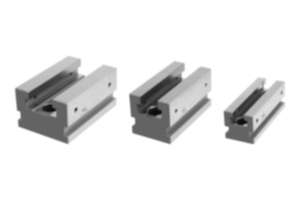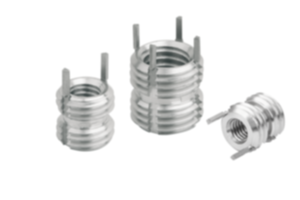Material
Double wedge and clamping segments mild steel.
Version
Double wedge and clamping segments hardened, phosphated.
Show more
Show less
Wedge clamps, Form A, smooth jaw face
from
€136.50
plus sales tax
plus shipping costs
Wedge clamps, Form B, jaw face serrated
from
€173.25
plus sales tax
plus shipping costs
Wedge clamps, Form C, with step
from
€178.50
plus sales tax
plus shipping costs
Wedge clamps, Form D, with machining allowance
from
€141.75
plus sales tax
plus shipping costs
Wedge clamps, Form E, with jaw pins
from
€205.00
plus sales tax
plus shipping costs
Description
Product description
The functioning principle make the wedge clamps ideal for multi-clamping.
The wedge shape creates high clamping forces.
The wedge clamps can be used for clamping in conjunction with the clamping rail or mounted in tapped holes or T-slots.
Tightening the clamping screw moves the two clamping segments outwards and press the workpieces against the fixed jaws of the machining fixture.
The double wedge has an elongated hole allowing for movement and to compensate for tolerances.
Displacement: M12 = ±1 mm, M16 = ±1.5 mm.
The wedge shape creates high clamping forces.
The wedge clamps can be used for clamping in conjunction with the clamping rail or mounted in tapped holes or T-slots.
Tightening the clamping screw moves the two clamping segments outwards and press the workpieces against the fixed jaws of the machining fixture.
The double wedge has an elongated hole allowing for movement and to compensate for tolerances.
Displacement: M12 = ±1 mm, M16 = ±1.5 mm.
Material
Double wedge and clamping segments mild steel.
Version
Double wedge and clamping segments hardened, phosphated.
Note
The two screw-on holes in the clamping faces also enable seating ledges to be mounted so as to optimise the clamping depth of the workpieces.
Scope of delivery
Wedge clamps.
Fastening screw.
Fastening screw.
Drawing reference
Form A: Smooth jaw face
Form B: Serrated jaw facet
Form C: With step
Form D: With machining allowance
Form E: With jaw pins
Form B: Serrated jaw facet
Form C: With step
Form D: With machining allowance
Form E: With jaw pins




















